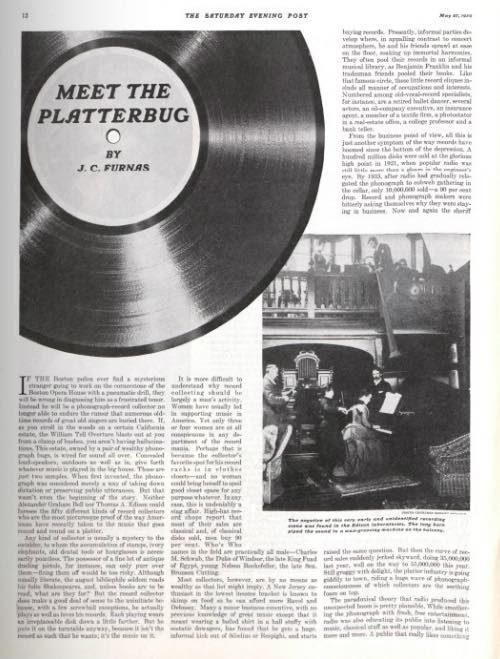The Invention of the Vinyl Junkie
Edison announced his new invention, the phonograph, 140 years ago today. He originally intended his recording technology to be used for dictation and historic utterances, but the public wanted something to dance to, and a booming business in music was born. The place of the record album in the history of music playback is unique: unlike other mediums for sound — the fleeting 8-track, for example — the phonograph record has demonstrated a seemingly timeless staying power in the market.
It would seem that records were always meant to be amassed and cherished. The Post’s 1939 story, “Meet the Platterbug,” explored the early obsession with thrift store finds and rarities. The “platter industry,” as it was called, suffered from the advent of the radio in the 1920s, but records were selling even better within 10 years: “The paradoxical theory that radio produced this unexpected boom is pretty plausible. While smothering the phonograph with fresh, free entertainment, radio was also educating its public into listening to music.” The new, musically-versed people wanted to be their own deejays, and they had tastes.
Record collectors in 1939 didn’t have the same breadth of options as a vinyl fanatic nowadays, but music zealots like novelist Dorothy Baker and famed collector Ulysses Walsh were pioneers in the hobby. Collections of hot jazz, Hungarian gypsy music, classical, hillbilly ballads, and even readings of James Joyce had “the variety of a drink list and the confused effect of a pack rat’s nest” on outsiders to the trade. That much hasn’t changed.
The self-proclaimed “live music capital of the world,” Austin, Texas, is saturated with lovers of the melodic and the vintage, so it makes sense that it currently hosts one of the most epic record swaps in the world, the Austin Record Convention. Doug Hanners started the show over 40 years ago, and he doesn’t believe record collecting ever lost much popularity. Collectors from around the world travel to his warehouse each year with hopes of buying or selling some special “platters,” and the general rule is that obscurity drives demand.

“Something about the human spirit drives people to accumulate stuff,” Hanners said.
Vinyl collectors aren’t just passing back and forth mummified music either. Records sales were the highest in 2015 that they’ve been since 1988 while CD sales dropped, according to Fortune. Plenty of new music is pressed on vinyl, and Sony recently announced that it would begin making records again after 28 years away from the medium. “You can see the cover, touch it, read the liner notes, even smell it. It’s not like other music formats,” according to Hanners.
There is a distinction between a casual collector and a full-on vinyl junkie, however, and it might be somewhere around the thousandth purchase. A Cuban doctor, described in “Meet the Platterbug,” left more than 20,000 operatic vocal recordings when he died. Similar aficionados can be found today. Jeff Gold is one of the biggest names in music collecting. He has worked with Rhino Records, A&M Records, and Warner Bros. as an art director, and his record collection is legendary. In an interview with Dust and Grooves, Gold described his method of quick browsing while searching through bins of records at a store: “in the 41 years I’ve been doing this, I have kind of an unconscious ability to stop at anything that looks interesting or different, without thinking about it. It just happens.” Gold’s stash includes some prized acetate records, namely his Bob Dylan recordings. Acetate was used to make records in the mid-century for, mostly, studio purposes. Although they wear more quickly, acetate platters are a treasured commodity in the collecting world.
With so many genres, small studios, and artists around, a vinyl addict could easily fill warehouses with discs given the budget, but Hanners says record collecting tends toward specialization these days: “The younger collectors tend to focus on specific genres, which will make their collections easier to sell when the time comes.”
And the time will eventually come. Like a stockpile of LPs, Hanners will soon turn over the reins of Austin Records to his son, Nathan, and — if current trends hold — the show will provide a fix to new generations of avid collectors.
